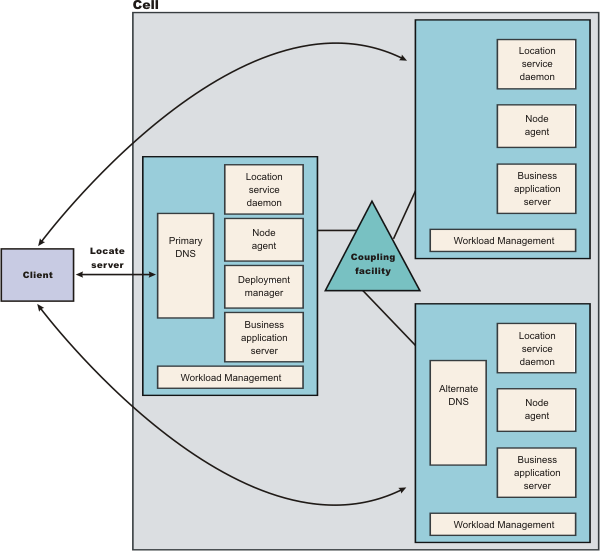Sysplex routing of work requests
The product uses the domain name server (DNS) to route work requests within a cell. We can use the DNS, instead of a sysplex distributor to distribute workload and balance requests for the same hostname across multiple IP addresses (one per daemon).
The DNS accepts a generic hostname from the client and maps the name to a specific system. The DNS works with workload management (WLM) to select the best available system. Workload management analyzes the current state of the cell and considers a number of factors, such as CPU, memory, and I/O utilization, when it determines the best system to handle new work. The DNS then routes the client request to that system. This use of workload management and the DNS is optional. However, using workload management and the DNS eliminates a single point of failure.

Each system in a cell has the product runtime. All the systems contain a location service daemon, node agent, and business application servers. One system acts as the deployment manager for the cell. The client uses the CORBA General Inter-ORB Protocol (GIOP) to send requests to the product. The location service daemon acts as a location service agent. It accepts locate requests with object keys in the requests. The location service daemon extracts the server cluster name from the object key, and then gives the server name to workload management. Workload management chooses the optimal server in the cell to handle the request. The location service daemon merges specific Interoperable Object Reference (IOR) information that is related to the chosen server with object key information stored in the original IOR. The result of this merging is a direct IOR that gets returned to the client. The client ORB uses this returned reference to establish the IOR connection to the server holding the object of interest.
The transport mechanism that the product uses depends on whether the client is local or remote. A client that is not running on the same z/OS system as the application server, is called a remote client, and requires a TCP/IP transport. If the client is local, the transport is through a program call. Local transport is faster because it does not require a physical trip over the network, eliminates data transforms, simplifies the marshalling of requests, and uses optimized Resource Access Control Facility (RACF ) facilities for security rather than having to invoke Kerberos or the SSL.
Related concepts